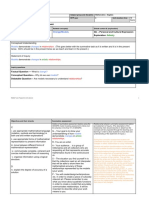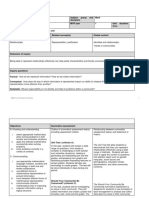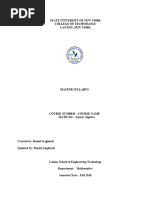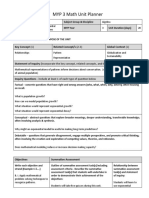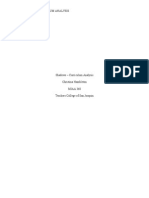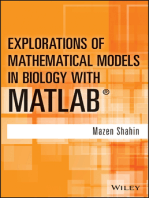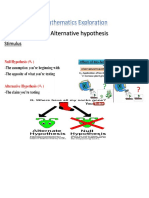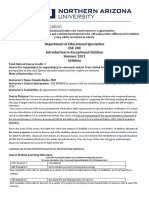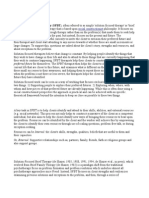MYP Unit Planner: Stage 1 - Establishing The Purpose of The Unit
MYP Unit Planner: Stage 1 - Establishing The Purpose of The Unit
Uploaded by
Lorraine SabbaghCopyright:
Available Formats
MYP Unit Planner: Stage 1 - Establishing The Purpose of The Unit
MYP Unit Planner: Stage 1 - Establishing The Purpose of The Unit
Uploaded by
Lorraine SabbaghOriginal Title
Copyright
Available Formats
Share this document
Did you find this document useful?
Is this content inappropriate?
Copyright:
Available Formats
MYP Unit Planner: Stage 1 - Establishing The Purpose of The Unit
MYP Unit Planner: Stage 1 - Establishing The Purpose of The Unit
Uploaded by
Lorraine SabbaghCopyright:
Available Formats
MYP unit planner
Teacher(s) Subject and discipline Mathematics
Unit title Linear Functions MYP year 3 Unit duration (hrs) 18
Stage 1 – Establishing the purpose of the unit
(Clarifications will be given in purple colour)
Key concept Related concept(s) Context
RELATIONSHIPS PATTERN SCIENTIFIC AND TECHNICAL INNOVATION
(Models)
REPRESENTATION
Statement of inquiry
CONCEPTUAL UNDERSTANDING: Patterns can be represented as relationships.
STATEMENT OF INQUIRY: Patterns can be represented as relationships in order to model and analyse their behaviour.
Inquiry questions
Line of inquiry: Students will investigate the different ways in which linear patterns can be represented.
MYP Unit planner review draft 23/10/2012
Factual – What is a pattern?
Line of inquiry: Students will discover how lines and the relationships between them can be described through the measure of their slope.
Conceptual – How is a relationship determined?
Line of inquiry: Students will explore whether natural phenomena can be modelled through representations using mathematics.
Debatable – What model is more natural, order or chaos?
Objectives & their strands Summative assessment
Criterion A: Knowing & Understanding Outline of summative assessment task(s) Relationship between summative assessment
(Topic test) including assessment criteria: task(s) and statement of inquiry:
select appropriate mathematics when solving Patterns can be represented as relationships in
problems order to model and analyze their behavior.
(G) The goal is for you to understand that patterns
apply the selected mathematics successfully can be represented as relationships in order to The summative task asks students to model the
when solving problems model and analyse their behaviour. Thus creating behaviour of a natural event (a hurricane) by
solve problems correctly in both familiar and a model about a natural phenomenon and its representing the pattern of its latitude and
unfamiliar situations in a variety of contexts potential damage. longitude over time. Using interpolation and
extrapolation, students will find that they can
(R) You are a meteorologist who analyses
predict the movement of such natural
Criterion C: Communicating (Hurricanes ‘R’ Us) geographic data
phenomena fairly accurately once the relationship
use appropriate mathematical language (A) Your work has to be presented to the City has been established.
(notation, symbols and terminology) in both board, who are responsible for making decisions
oral and written explanations in the city administration
use appropriate forms of mathematical (S) A natural disaster is about to hit a city and
representation to present information evacuation notices may need to be given.
move between different forms of
mathematical representation (P) You will create a written report for the City
communicate complete and coherent council and will present your findings.
MYP Unit planner review draft 23/10/2012
mathematical lines of reasoning
(S) Your report needs to include appropriate
organize information using a logical structure.
graphs and visuals that have a direct relation to
the model of the disaster situation. Use historical
data to show how accurate your model is and
Criterion D: Applying mathematics in real-world
justify that this would help in predicting the
contexts (Hurricanes ‘R’ Us)
outcome.
identify relevant elements of authentic real-
life situations
select appropriate mathematical strategies
when solving authentic real-life situations
apply the selected mathematical strategies
successfully to reach a solution
explain the degree of accuracy of a solution
explain whether a solution makes sense in the
context of the authentic real-life situation.
Approaches to learning (ATL) ATL can be for the Summative, Objective or Criteria and for the Learning Experience
ATL for the Criteria
In order for students to explain whether a solution makes sense in the context of the authentic real-life situation , they will have to draw reasonable
conclusions and generalizations. (ATL Category: Thinking, ATL Cluster: Critical Thinking).
In order for students to select and apply appropriate mathematical strategies when solving authentic real-life situations , they will have to collect and
analyse data to identify solutions and make informed decisions. (ATL Category: Research, ATL Cluster: Information Literacy) .
In order for students to use appropriate mathematical language (notation, symbols and terminology) in both oral and written explanations , they will have
to understand and use mathematical notation. (ATL Category: Communication, ATL Cluster: Communication skills) .
MYP Unit planner review draft 23/10/2012
ATL for the Task-
(Communication, Written Report- Teaching students the ways to write a report and include visuals)
(Research Skills- Students need to know how to research data, evaluate data and cite this information in their task)
Stage 2 –Planning for teaching and learning through inquiry
Content Learning Activities Formative Assessment Differentiation
ATL Skill: draw reasonable Inquiry Question: What is a pattern? A) The activities are scaffolded so that
conclusions and generalizations students who experience difficulty will
A) Exit slips (Students answer questions be led through the discovery of linear
A) The linear function f (x) = mx + A) Students work in pairs and groups on a slip of paper before they exit the functions. The teacher can provide
c, its graph, gradient and y- through the activities provided by the class, providing feedback to the teacher additional support where necessary
intercept teacher. There is an investigation on on their level of understanding.) and/or pair students so that a stronger
Line of Inquiry- The patterns can “How do you know it’s a line?” as well as student can help one who may struggle.
be classified on the basis of their on gradient-intercept form. Direct
instruction will take place on concepts
characteristics.
and skills that students may need to
review (intercepts, graphing, etc.)
Inquiry Question: How is a relationship
determined?
B) Parallel and perpendicular lines and ATL Skill: draw reasonable
the relationships between their B) Discussions with students as they B) Envelope hints are provided for the
conclusions and generalizations hand in their investigation. Checking of task with the following suggestions (in
gradients
B) Investigation activity (criterion B): their work as they complete practice order): 1) Graph the lines 2) Is
Line of Inquiry- The patterns can Students will investigate the relationship exercises leading up to the investigation. anything the same? 3) What do you
be represented in different ways between the gradients of parallel and notice about their gradients/slopes? 4)
MYP Unit planner review draft 23/10/2012
(graphically and algebraically) perpendicular lines. m1 x m2 = ______
ATL SKILL: collect and analyse data
to identify solutions and make
C) Finding the equations of lines given informed decisions
specific parameters C) “Cutting the umbilical cord”:
Line of Inquiry- Relationships Students will watch the teacher model
how to find the equation of a line given C) “Math Minute” quiz (Students get a C) The teaching strategy provides ample
between patterns can be
its parameters until they feel they can 20-question quiz to answer over the differentiation as students will decide
determined on the basis of
do it on their own. They will then move course of 4 classes. They are given 5-7 themselves when they are ready to try
certain attributes.
on to practice. The teacher continues minutes per class to complete as much problems on their own. The teacher
with examples as long as even one as they can. After every class the continues to provide guidance to those
student wants to see another one. teacher marks which ones the student who need it while those who learn more
When all students have “cut the has done correctly so that they can see quickly can begin practice earlier.
umbilical cord”, the teacher then acts as how they are doing with successive
a reference person while also verifying attempts.)
that students are being successful. If
not, then more examples are shown.
D) Solving linear equations algebraically D) Guided practice: In pairs, students
and graphically including simultaneous D) The practice exercises will increase in
will work on exercises supplied by the D) Student presentations of their work
equations difficulty, beginning with the most basic
teacher. These will begin with single on mini whiteboards.
of linear equations. Acting as a
linear equations and then move into
resource, the teacher can provide more
simultaneous equations.
support to those who need it. If desired,
envelopes with “hints” in them can be
used for specific questions that are
difficult. Manipulatives can also be used
if necessary.
E) Students analyse the rates of E) Guided practice: In pairs, students
deforestation and the predicted loss of will work on the scenaron supplied by
rain forest by analysing data the teacher.
MYP Unit planner review draft 23/10/2012
Resources
Video “27 Storms” (NASA)
Atlases
Graphic Display Calculators (GDC)
Stage 3 – Reflecting and evaluating
Prior to teaching the unit During teaching After teaching the unit
Students should be fairly comfortable with graphing Students quickly picked up on how they know The summative task went really well and students
points so that we can focus on linear functions. The something is linear just by looking at the equation. needed very little help in finding the equations.
teacher last year showed them how the solution to a That investigation went really well. They also had no Graphing the data, however, took a little longer since
linear equation can be represented graphically so that problem finding how the gradients of parallel lines the times were in Greenwich Mean Time. Next time,
should be a good introduction to linear functions as relate. A few did need some help with how to write though, I will change them to EST and I’ll also have to
well as to systems of simultaneous equations (if they the relationship between gradients of perpendicular ask students to “find the model/equation” since many
remember!). Last year they studied Pompeii so lines mathematically. However, once hey saw it, they asked what a “model” was. I should have emphasized
introducing the unit with the video should prove to be said it made a lot of sense. Students need a lot of that a little more.
pretty motivating. I’m a little worried about the time reinforcement of vocabulary such as “intercepts” so
for the investigations and covering it all in the 15 I’ve decided to have them make flashcards with key
hours. words on them (like they do in History). Finding the The test included a variety of questions that I thought
equation of a line is going pretty well, though some would be challenging but, in general, all of the students
students wished I would just tell them which form to were successful. They found the skills questions almost
use all the time. They don’t seem to like having a too easy! Most students achieved a 5 or better!
choice.
Because of the work we did in discovering the different
aspects of linear functions, the section on solving
simultaneous equations was really easy. Students
MYP Unit planner review draft 23/10/2012
quickly picked up on when (and why) there would be
no solution and they could guess how the two lines
might look even before graphing. They still struggle
somewhat with fractions, but the more I infused them
in practice problems, the more comfortable they
became with them. I decided to do a “WHOLE
NUMBERS ARE ON STRIKE” class so students knew
what t expect. It went pretty well!
The Math Minute was really helpful here since students
quickly figured out how much or how little they knew.
I’m still unsure how much time to give every class since
some kids were done after 2 classes while a few didn’t
finish all 20 questions after the 5 classes I gave them
(though they weren’t far off).
MYP Unit planner review draft 23/10/2012
You might also like
- Physics - Motion Unit Plan Student Teacher 4Document9 pagesPhysics - Motion Unit Plan Student Teacher 4api-29200044885% (13)
- MYP 2 IntegersDocument6 pagesMYP 2 IntegersYomna SherifNo ratings yet
- Prerequisite Content-Knowledge:: Adaptive Teaching GuideDocument6 pagesPrerequisite Content-Knowledge:: Adaptive Teaching GuideJach Oliver100% (1)
- Mathematics MYP 2 - Unit PlannersDocument42 pagesMathematics MYP 2 - Unit Plannershemendu nandanNo ratings yet
- MYP 3 Math Unit Planner - Linear FunctionsDocument4 pagesMYP 3 Math Unit Planner - Linear FunctionsKelly Orosz50% (2)
- HL Paper3aDocument5 pagesHL Paper3aLorraine SabbaghNo ratings yet
- NEXT CHAPTER MYP UP 9 Linear RelationshipsDocument6 pagesNEXT CHAPTER MYP UP 9 Linear RelationshipsLorraine SabbaghNo ratings yet
- Mathematics in The Modern WorldDocument3 pagesMathematics in The Modern WorldWc-mark ChuvachucHu0% (1)
- Maths G10e U2 - Functions GraphsDocument6 pagesMaths G10e U2 - Functions Graphsapi-429688581100% (1)
- Quadratic FunctionDocument6 pagesQuadratic FunctionJoel Logbo0% (1)
- G10 Unit 1 Ext - STD Periodic Phenomena Unit PlannerDocument4 pagesG10 Unit 1 Ext - STD Periodic Phenomena Unit PlannerYueping ShanNo ratings yet
- NEXT CHAPTER MYP UP 9 Linear RelationshipsDocument7 pagesNEXT CHAPTER MYP UP 9 Linear RelationshipsAmos D'Shalom Irush100% (1)
- Unit Planner - GeometricConstructions - Y14Document6 pagesUnit Planner - GeometricConstructions - Y14Deema El Masri100% (1)
- Maths G10e U1Document10 pagesMaths G10e U1api-429688581No ratings yet
- Unit - Planner - Bivariate - Data Y35Document6 pagesUnit - Planner - Bivariate - Data Y35moukoddim sadikouNo ratings yet
- Curriculum Analysis WeeblyDocument8 pagesCurriculum Analysis Weeblyapi-281968762No ratings yet
- Unit Planner - DataManagement - Y16Document5 pagesUnit Planner - DataManagement - Y16Deema El MasriNo ratings yet
- Math G8U2 Linear Relationships and Functions UbD 22-23Document8 pagesMath G8U2 Linear Relationships and Functions UbD 22-23mhobarNo ratings yet
- Ratios and ProportionsDocument6 pagesRatios and ProportionsThe Nextwave-DepatsNo ratings yet
- Myp Math Standard Unit 02Document4 pagesMyp Math Standard Unit 02Suran LeeNo ratings yet
- Stage 1 - Desired Results: Understanding by DesignDocument3 pagesStage 1 - Desired Results: Understanding by DesignLuis AlbertoNo ratings yet
- Digital Unit Plan Template Unit Title: Graphing Functions Name: Daniel Ruvalcaba Content Area: Algebra 2 Grade Level: 11thDocument3 pagesDigital Unit Plan Template Unit Title: Graphing Functions Name: Daniel Ruvalcaba Content Area: Algebra 2 Grade Level: 11thapi-431410685No ratings yet
- The Ontario Curriculum, - Grades 11 Mathematics - 2007Document13 pagesThe Ontario Curriculum, - Grades 11 Mathematics - 2007julieyingjieNo ratings yet
- SEHH2241 - Discrete StructureDocument3 pagesSEHH2241 - Discrete StructureGlory of Billy's Empire Jorton KnightNo ratings yet
- Form Representation, Justification Fairness and Development: Accessing Equal OpportunitiesDocument6 pagesForm Representation, Justification Fairness and Development: Accessing Equal OpportunitieskolawoleNo ratings yet
- Shelton 5e-Lesson-PlanDocument10 pagesShelton 5e-Lesson-Planapi-595118822No ratings yet
- Curriculum 1b 19187336 Minh Phuong Nguyen 2ndDocument38 pagesCurriculum 1b 19187336 Minh Phuong Nguyen 2ndapi-374403345No ratings yet
- MYP2 2D and 3D ShapesDocument6 pagesMYP2 2D and 3D ShapesYomna SherifNo ratings yet
- Modul MTK KLS 8 Bab 3.3Document12 pagesModul MTK KLS 8 Bab 3.3Gunawan CHtNo ratings yet
- Lesson Plan - StatisticsDocument15 pagesLesson Plan - Statisticsapi-448318028No ratings yet
- Advanced Mathematical Thinking PDFDocument18 pagesAdvanced Mathematical Thinking PDFJavier MazoNo ratings yet
- Myp Math Extended Unit 02Document6 pagesMyp Math Extended Unit 02vato otavNo ratings yet
- Geometry Unpacked ContentDocument77 pagesGeometry Unpacked ContentHazem EmadNo ratings yet
- Algebra 2 BCBETTUISDWebsite Info Springnew 2016Document12 pagesAlgebra 2 BCBETTUISDWebsite Info Springnew 2016Tech OnlyNo ratings yet
- MATH361Document6 pagesMATH361Bala RamNo ratings yet
- Advanced AlgebraDocument11 pagesAdvanced AlgebraJoseph ParadoNo ratings yet
- MYP2 RatesDocument6 pagesMYP2 RatesYomna SherifNo ratings yet
- CS 312: Algorithm Analysis: Syllabus, Fall 2008Document8 pagesCS 312: Algorithm Analysis: Syllabus, Fall 2008Jeff PrattNo ratings yet
- Discrete Mathematics SyllabiDocument1 pageDiscrete Mathematics SyllabiAkkayya Naidu BonuNo ratings yet
- Chapter 111. Texas Essential Knowledge and Skills For Mathematics Subchapter C. High SchoolDocument17 pagesChapter 111. Texas Essential Knowledge and Skills For Mathematics Subchapter C. High Schoolascap85No ratings yet
- MYP 3 Unit Planner - Exponential FunctionsDocument4 pagesMYP 3 Unit Planner - Exponential FunctionsKelly OroszNo ratings yet
- Hambleton Curriculum AnalysisDocument14 pagesHambleton Curriculum Analysisapi-270424561No ratings yet
- Mathematics Subject Group Overview 2015-16 2Document18 pagesMathematics Subject Group Overview 2015-16 2fjediNo ratings yet
- Modul MTK KLS 8 Bab 5.3Document11 pagesModul MTK KLS 8 Bab 5.3Gunawan CHtNo ratings yet
- Grade 9 MathematicsDocument8 pagesGrade 9 Mathematicsjdvicente.upNo ratings yet
- LP_Sci7_Q1_W1Document4 pagesLP_Sci7_Q1_W1Sugar Rey Rumart RemotigueNo ratings yet
- Lesson Plan Draft (2023)Document3 pagesLesson Plan Draft (2023)李南羲No ratings yet
- G10 Unit 4 Ext - STD Logarithms Unit PlannerDocument4 pagesG10 Unit 4 Ext - STD Logarithms Unit PlannerYueping ShanNo ratings yet
- MHF4U Unit 3 ExamplerDocument8 pagesMHF4U Unit 3 ExamplerGaganpreet KaurNo ratings yet
- Adv Algebra Unit 1Document6 pagesAdv Algebra Unit 1api-264152935No ratings yet
- Unit Plan Myp 1 2nd MPDocument9 pagesUnit Plan Myp 1 2nd MPkolawoleNo ratings yet
- Unit 1 PatterningDocument52 pagesUnit 1 PatterningTRYSKANo ratings yet
- Ubd QuadraticsDocument3 pagesUbd Quadraticsapi-355509602No ratings yet
- Assignment 2 SMN3043 A211Document4 pagesAssignment 2 SMN3043 A211ChimChim UrkNo ratings yet
- Projects MATH61000Document11 pagesProjects MATH61000janiarun9No ratings yet
- Zhixings Unit Plan On Quadratic EquationsDocument15 pagesZhixings Unit Plan On Quadratic Equationsapi-351066982No ratings yet
- 21 Charlotte BurryPaperEdit2Document6 pages21 Charlotte BurryPaperEdit2Felipe PiresNo ratings yet
- MPM2D1Document2 pagesMPM2D1anotheroadsideNo ratings yet
- Chapter 111. Texas Essential Knowledge and Skills For Mathematics Subchapter C. High SchoolDocument34 pagesChapter 111. Texas Essential Knowledge and Skills For Mathematics Subchapter C. High SchoolRedika RiasariNo ratings yet
- Visualization and Interpretation: Humanistic Approaches to DisplayFrom EverandVisualization and Interpretation: Humanistic Approaches to DisplayNo ratings yet
- Ib Mathematics HLDocument127 pagesIb Mathematics HLLorraine Sabbagh100% (1)
- Student Highlights Significant Features of Function and Defines Them in The Context of The ExplorationDocument2 pagesStudent Highlights Significant Features of Function and Defines Them in The Context of The ExplorationLorraine SabbaghNo ratings yet
- (34 Marks) : 28 Ab, B R 28 TDocument7 pages(34 Marks) : 28 Ab, B R 28 TLorraine SabbaghNo ratings yet
- Session 5: Modelling Actvity Data: BiologyDocument3 pagesSession 5: Modelling Actvity Data: BiologyLorraine SabbaghNo ratings yet
- Methodology: Image of An Oxer Vertical of A Horse JumpDocument5 pagesMethodology: Image of An Oxer Vertical of A Horse JumpLorraine SabbaghNo ratings yet
- Mathematics Higher Level Internal Assessment ExplorationDocument9 pagesMathematics Higher Level Internal Assessment ExplorationLorraine SabbaghNo ratings yet
- Scenario 1. Wake Up Early or Sleep In?: Presentation of DataDocument1 pageScenario 1. Wake Up Early or Sleep In?: Presentation of DataLorraine SabbaghNo ratings yet
- Mathematics Higher Level Internal Assessment - ExplorationDocument8 pagesMathematics Higher Level Internal Assessment - ExplorationLorraine SabbaghNo ratings yet
- IB Maths HL Exploration Research: Stimulus: Do Bees Know Maths?Document2 pagesIB Maths HL Exploration Research: Stimulus: Do Bees Know Maths?Lorraine SabbaghNo ratings yet
- HL Exploration Research-Normal Distribution: Stimulus: What Do You Expect The Knock Board Outcome?Document2 pagesHL Exploration Research-Normal Distribution: Stimulus: What Do You Expect The Knock Board Outcome?Lorraine SabbaghNo ratings yet
- An Example of Data Analysis: Mathematics Higher Level Internal Assessment ExplorationDocument15 pagesAn Example of Data Analysis: Mathematics Higher Level Internal Assessment ExplorationLorraine SabbaghNo ratings yet
- SIR ModelDocument2 pagesSIR ModelLorraine SabbaghNo ratings yet
- Null and Alternative Hypothesis: StimulusDocument3 pagesNull and Alternative Hypothesis: StimulusLorraine SabbaghNo ratings yet
- Sample 3Document2 pagesSample 3Lorraine SabbaghNo ratings yet
- Statistical Modelling On Shanghai's PopulationDocument2 pagesStatistical Modelling On Shanghai's PopulationLorraine SabbaghNo ratings yet
- What Makes A Coffee Shop Successful On Street 51?Document3 pagesWhat Makes A Coffee Shop Successful On Street 51?Lorraine SabbaghNo ratings yet
- For Good Websites For Exploration Inspirations Try:: 1. Dan MeyerDocument2 pagesFor Good Websites For Exploration Inspirations Try:: 1. Dan MeyerLorraine SabbaghNo ratings yet
- Mind Map ExamplesDocument18 pagesMind Map ExamplesLorraine SabbaghNo ratings yet
- 2 Methodology - FDocument2 pages2 Methodology - FLorraine SabbaghNo ratings yet
- Lesson 2 Historical Cultural and Legal Ethical ConsiderationsDocument6 pagesLesson 2 Historical Cultural and Legal Ethical ConsiderationsGuidance CenterNo ratings yet
- 200 Hour Teacher Training Manual: Learning & Teaching The Yogic SystemDocument199 pages200 Hour Teacher Training Manual: Learning & Teaching The Yogic SystemBhavin VoraNo ratings yet
- Hugging FaceDocument1 pageHugging Faceyngy7kd9cqNo ratings yet
- Accelerating Innovation in Healthcare: Presented byDocument12 pagesAccelerating Innovation in Healthcare: Presented byPadmini PonugupatiNo ratings yet
- Creotec WorkbookDocument31 pagesCreotec WorkbookRigel RiveraNo ratings yet
- Weekly Home Learning Plan DRAFTING 8 Week 1 3Document6 pagesWeekly Home Learning Plan DRAFTING 8 Week 1 3John B. BataraNo ratings yet
- Elegant Wire and Bead Crochet Jewelry 649919Document6 pagesElegant Wire and Bead Crochet Jewelry 649919Wilma Gonzalez0% (3)
- Urban Art Proposal - Katya CoultonDocument3 pagesUrban Art Proposal - Katya Coultonapi-276849976No ratings yet
- Department of Educational Specialties ESE 280 Introduction To Exceptional Children Summer 2021 SyllabusDocument6 pagesDepartment of Educational Specialties ESE 280 Introduction To Exceptional Children Summer 2021 SyllabusYarely RodriguezNo ratings yet
- Basics of Apa Style (Tutorial)Document2 pagesBasics of Apa Style (Tutorial)lanaNo ratings yet
- Ghana Power Compact Internship and Mentoring Program: Call For Applications - 2021Document1 pageGhana Power Compact Internship and Mentoring Program: Call For Applications - 2021Benyiwah AmoahNo ratings yet
- Cui Vs Arellano UniversityDocument2 pagesCui Vs Arellano UniversityPam Otic-ReyesNo ratings yet
- Inflatia - AbstractDocument6 pagesInflatia - AbstractMioara CialîcuNo ratings yet
- Setting Goals and Writing A Goals MemorandumDocument2 pagesSetting Goals and Writing A Goals MemorandumJustin JenkinsNo ratings yet
- ai - attitude of nursing studentDocument4 pagesai - attitude of nursing studentHema Malini ArmugamNo ratings yet
- BerberianDocument329 pagesBerberianMariaElisabettaTrupianoNo ratings yet
- Research Methods-HandoutsDocument16 pagesResearch Methods-HandoutsArki TorniNo ratings yet
- Science 5 - Q4 - W2Document5 pagesScience 5 - Q4 - W2Mathleen DescalzoNo ratings yet
- ESMT Berlin Global Online MBA BrochureDocument15 pagesESMT Berlin Global Online MBA Brochureggfm5st6gmNo ratings yet
- Solution Focused Brief Therapy (SFBT), Often Referred To As SimplyDocument2 pagesSolution Focused Brief Therapy (SFBT), Often Referred To As SimplyM2TE4100% (1)
- Aesthetic Pleasure and PainDocument6 pagesAesthetic Pleasure and PaincosiNo ratings yet
- Quiz No. 1Document3 pagesQuiz No. 1Keaven Rold FormilosNo ratings yet
- Collection of University Question Papers Ii Year MBBS: 1990 - 2009 TKMC 007 BatchDocument23 pagesCollection of University Question Papers Ii Year MBBS: 1990 - 2009 TKMC 007 BatchSubramaniam KrishnamoorthiNo ratings yet
- Unit 8 Test: Listening Language FocusDocument2 pagesUnit 8 Test: Listening Language Focusjachy72No ratings yet
- SampleDocument9 pagesSampleRito DitoNo ratings yet
- NHD Student Workbook - MNDocument24 pagesNHD Student Workbook - MNapi-261948345No ratings yet
- Handbook of Research On Emerging Pedagogies For The Future of Education, Trauma-Informed, Care, and Pandemic Pedagogy Aras BozkurtDocument535 pagesHandbook of Research On Emerging Pedagogies For The Future of Education, Trauma-Informed, Care, and Pandemic Pedagogy Aras BozkurtBrenda MoysénNo ratings yet
- John Dewey and His Philosophy of Education PDFDocument6 pagesJohn Dewey and His Philosophy of Education PDFAlchazidou Elpida100% (1)
- School CertificateDocument1 pageSchool Certificatemhmdtjryby119No ratings yet
- Literature Review Example in Apa FormatDocument4 pagesLiterature Review Example in Apa Formatafdtliuvb100% (1)









